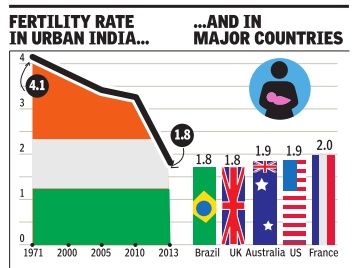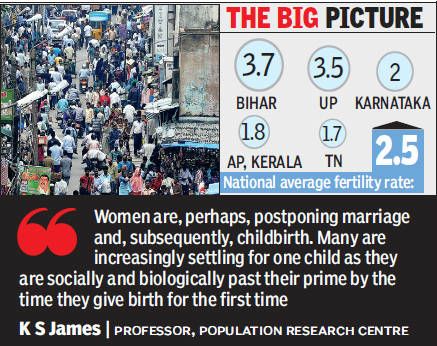Population growth and fertility rate: India
This is a collection of articles archived for the excellence of their content. |
In brief
The Times of India, 28 March 2013
Saswati Mukherjee
South India lags national fertility rate, slows population boom
India's burgeoning population appears to be both a problem and an advantage. Very soon, the southern states are likely to stare at an un-Indian situation: a shrinking populace, owing to a sharp dip in the fertility rate of women.
Analyzing the 2011 Census data, the Population Research Centre of the Bangalore-based Institute for Social and Economic Change found that many southern districts, a significant number of them in Karnataka, have recorded fertility rates lower than the national average. The study says turnaround will happen soon.
Half of India's 1.21 billion population comprises women, and the national average fertility rate stands at 2.5, slightly higher than the targeted 2. The theory is simple: two children replace two parents, and the population remains stagnant.
Experts say women in most southern states appear to be settling for one child, pulling down the average fertility rate.
Karnataka's overall fertility rate stands at 2, but there's an interesting variation in the districts. In Udupi, for instance, the fertility rate is 1.2; in Hassan, Mandya and Chikmagalur, it's 1.4; in Dakshina Kannada and Kodagu, it's 1.5. Bangalore, at 1.7, is well below the national average. Some districts, though, have high fertility rates: Bijapur stands at 3, and Bidar at 2.7.
The other South Indian states of Kerala, Andhra Pradesh and Tamil Nadu are in the sub-2 category.
"Women are, perhaps, postponing marriage and, subsequently, childbirth. Many are increasingly settling for one child as they are socially and biologically past their prime by the time they give birth for the first time," said K S James, professor, Population Research Centre, who led the data analysis.
SUDDEN DISARRAY
What happens if the population shrinks? Arresting the spiralling population growth rate has always topped the nation's agenda. Experts, though, beg to differ. A sudden turnaround in population could lead to demographic disarray, they say. "The first result of negative population growth is the number of elderly people goes up and young people comes down. This means there are fewer youngsters to take care of our elderly," said Prof. K S James.
WOMEN MAKE INFORMED CHOICE
Experts say women make an informed choice to have a single child, given the high literacy level in the southern states.
"Often, this is to give the lone child a good quality of life. Keeping in mind the high cost of living, young couples are increasingly settling for one child," said retired ISEC professor KNM Raju.
With both men and women being educated, they make informed decisions. "The woman's decision today is well thought out, and she has her partner's support too," said Raju.
The implication could be quite significant. If both partners in a marriage are themselves from single-child families, the responsibility of taking care of both sets of parents falls on them. "Parents these days are not dependent on their children financially. It's the psychological dependence which will be missed the most," Raju pointed out.
Experts attribute this trend to the southern states being open to change. "It's their willingness to accept social changes that work for them," said Raju.
NORTH-SOUTH DIVIDE
Unlike their southern counterparts, the northern states are showing an increase in fertility rate. The country is evenly poised, with half the country adhering to the national average and below, and the other half exceeding the figure.
Experts point to high awareness and education levels and successful family planning programmes in the southern states for low fertility rate figures. Rajasthan, Uttar Pradesh, Madhya Pradesh and Bihar, though, have the highest fertility rates in the country, experts say.
Fertility rate, region-wise
In urban India lower than in US, Oz, France
The Times of India, May 14 2016

Fertility rate in India's cities lower than in US, Oz, France
Atul Thakur
For most people, the gene ral perception about In dia is of a country sitting on a ticking population bomb.This notion, however, seems to be somewhat misplaced, at least in the context of the country's urban population where the fertility rate -the number of children born per woman -has fallen to levels lower even than those in countries like the US, France, Australia and New Zealand. Data from the Sample Re gistration Survey (SRS) shows that since 2006, total fertility rate (TFR) in urban areas has touched two children per woman and from 2010, has fallen below that level.That means there aren't enough children born in Indian cities to replace the existing population of their parents.For advanced economies, this `replacement rate' is generally estimated at an average of 2.1. Because of the higher infant mortality rate (IMR) in developing countries, the replacement level fertility rate would be slightly higher and so Indian cities seems to have touched the point where the population would start declining in the absence of migration from rural areas.
Is this an alarming trend? Experts don't think so: “2.1 is more like a synthetic number.During fertility transition, the total fertility could go below 2.1 and stabilise in a decade or two“, says population expert Purushottam M Kulkarni, who recently retired from JNU. Ravinder Kaur, professor of sociology and social anthropology at IIT Delhi, points out a similar pattern of low fertility across Asia and in Catholic southern Europe.
“Although the IMR is substantially high compared to western countries, it is not as alarming as it used to be and there is a general confidence in the population that the chances of a child's survival are higher compared to the past decades and hence fertility is low,“ added Kulkarni. Data shows that in 1971, the infant mortality rate was 82 (per 1000 births) and total fertility rate was 4.1for urban India.
Though the rural fertility rate of 2.5 is higher, it too has witnessed a steep decline over the years. In 1971, the rural fertility rate was 5.4, nearly double its present level. Incidentally , in 1952, India became the first country in the world to launch a family planning programme. The sustained government campaign, better access to healthcare facilities, higher female literacy and more participation of women in the workforce have all worked in lowering fertility rates in cities. Many couples prefer one child, although this is not the general norm.
“The fewer children preference allows the middle class to rise up the social ladder by investing more in them is gendered with preference of sons over daughters. Sons bring dowries and investing in their education helps families move up socially ,“ says Kaur. Professor Kulkarni, however, points out that there are regional differences as southern states have lower fertility and better sex ratios.
